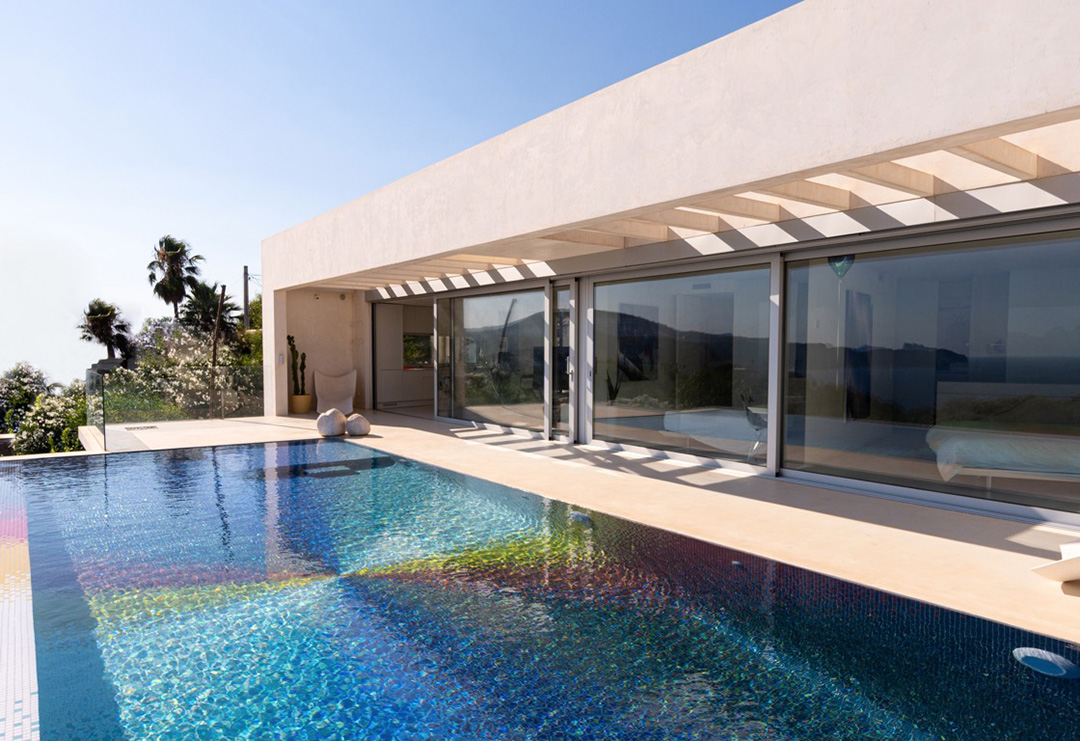An unspoilt corner of the Mediterranean coast is the site of a somewhat unusual art intervention. Felipe Pantone chose the bottom of a swimming pool in a seafront home in Jávea (Spain) to express his art with an optical effect created with thousands of mosaic tesserae by ONIX.
STORY & PHOTOS BY ONIX
Felipe Pantone is an Argentinean-Spanish artist renowned for his colourful, pixeled and digitalised art works. . In this project, the interior of a traditional swimming pool has provided this creative artist with the backdrop for an underwater prismatic spiral of colour formed by glass mosaic tiles.
Pantone defined 7 different colours for the design, which features some 130,000 glass mosaic tiles. The result is another skilful transformation of space by the artist through a design and choice of a powerful material in a space that previously went completely unnoticed. Pantone has once again successfully created a large-scale project in a clever play on colour and light, and on this occasion adding a further element: water.
An Infinite Pool
The swimming pool is part of the architectural complex of a contemporary, minimalist home boasting a prime seafront location. Named the “infinite pool” by Pantone, it stands out for the intense colours of the glass mosaics that form a striking contrast with the white building, the work of architect Esther Santos.
Pantone is well-known for his use of light and colour and in this intervention he has created a mosaic spectrum in tones of blue, yellow and red that merges individual pixels in a constantly shifting rainbow.
The mosaic tiles appear to be in constant movement
The swimming pool is vibrancy in its essence. The mosaic tiles appear to shift with the movement of the water. The small inch-sized mosaics allow the colours to merge with one another, creating a surprising and changing optical effect. The rippling water, combined with the constantly shifting light gives the appearance of a living design in permanent movement.
According to Pantone, his intention was “to create an effect that had never been seen in a pool before: an underwater design that focuses on the light. The colours from the diffracted light submerged in the reflections of the water”. “I love the contrast it forms with the rest of the house, with its clean-cut forms, as well as with the views and the setting”, he added.
The design radiates from the centre of the pool and the mosaic tiles spread outwards in a flowing movement that extends to the side walls, thereby increasing the optical illusion to maximum effect.
The artistic process begins with a digital phase using several computer programs to create designs that can later be converted into friezes, murals, paintings and sculptures that add a sense of touch and texture to creations that stem from the digital world.
Felipe Pantone: dynamism, transformation and the digital revolution
Felipe Pantone is an Argentinean-Spanish artist who began creating graffiti at the age of 12 . He obtained a degree in Fine Arts in Valencia (Spain), where his studio is located. Pantone’s work is based on the concepts of dynamism, transformation, the digital revolution and current-day themes.
His work is acclaimed throughout the world, and has been featured at international exhibitions and installations in cities such as Paris, Mexico City and London. He has also exhibited in Italy, Palestine, Japan and Australia. Furthermore, in 2017, he painted what at the time was Portugal’s tallest mural.
Thanks to his bold use of colour and geometry, Pantone’s aesthetic has been described by Forbes as “the intersection between Blade Runner and PhotoShop”.
Felipe Pantone Residential
Location: Javea, Spain
Year: 2022
Design: Felipe Pantone
Photography: Felipe Pantone
